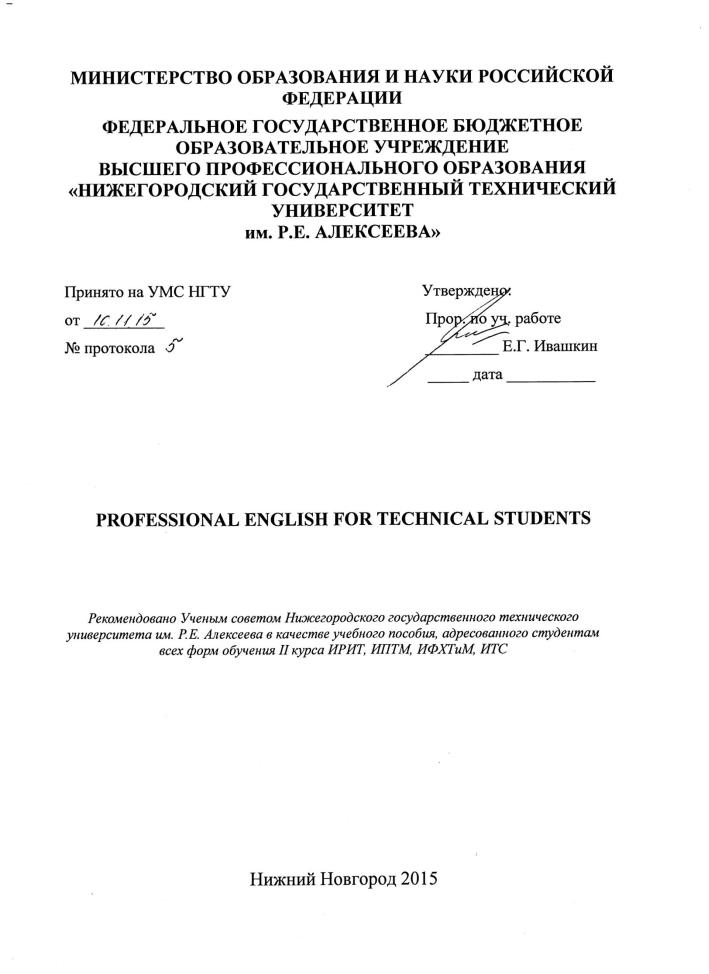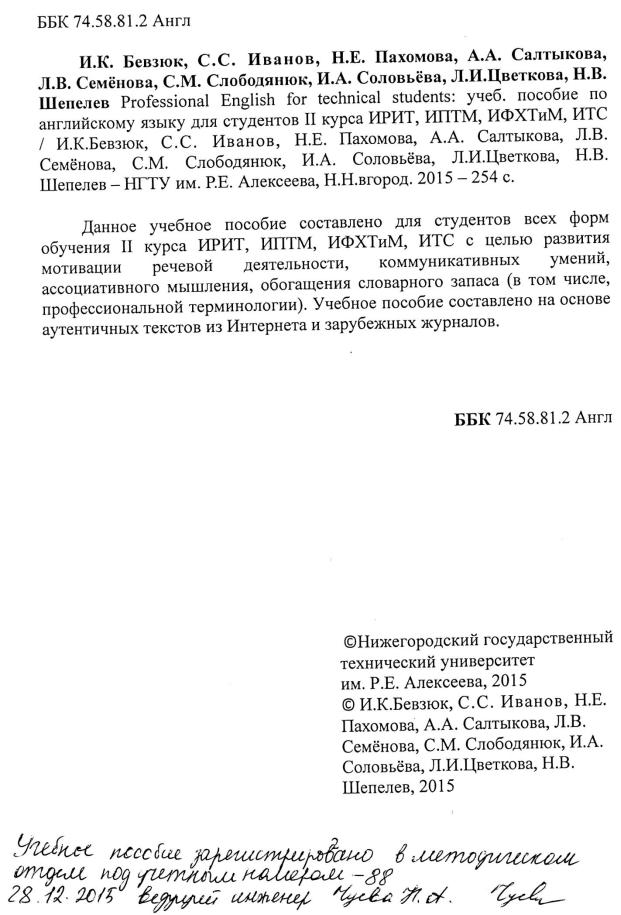
Методичка по английскому языку для ИТС (пр. С.С.Иванов)
.pdf

2
|
|
Оглавление |
Module 1. Shipbuilding ................................................................................................. |
3 |
|
Module 2. |
Chemical matters ....................................................................................... |
99 |
Module 3. |
Machine building ..................................................................................... |
141 |
Module 4. |
Information security................................................................................. |
190 |
Module 5. |
Nanotechnology ....................................................................................... |
220 |
Module 6. ESP Grammar .......................................................................................... |
234 |
|
3
Module 1. Shipbuilding
UNIT 1
Types of ships
On the one hand, all cargo ships are divided into two main types: dry cargo ships1 and tankers. On the other hand, cargo ships may be divided into universal ships2 designed to carry principal different types of cargo and specialized ships designed to carry one type of cargo (e.g. bulk cargo3, timber4, refrigerated goods5, oil6).Such specialized ships as bulkers (bulk- carries) ,timber-carriers, reefer ships7, tankers have long been known. In the past two decades three trends in specialized ships design have emerged. One is cargo-carriers with cargo-handling equipment8 on board for special purposes or routes (e. g. heavy/bulky cargo ships9 with derricks10 or cranes11 capable of handling single lifts over 500 tons without requiring outside assistance. The ships are also called special-purpose ships.
The second trend is Roll-on/Roll-off ships12 in which bow13 and stern14 doors and adjustable steel ramps15 permit vehicles to drive on board and drive off again requiring only minimum door-side facilities16.
The third trend is the container ship17. The use of containers for cargoes has encouraged18 the design of ships to carry containers. In their extreme form the container is a 60-foot steel lighter which can be quickly launched over the ship‘s stern.
A comparatively new development is the multi-purpose ship combining characteristic features of both universal and specialized vessels.
Notes
dry cargo ship – сухогрузное судно
3
universal ship – универсальное судно bulk cargo – навалочный груз
timber – лес
refrigerated cargo – рефрижераторный груз oil – нефть
reefer = reefer ships – суда для перевозки рефрижераторных грузов
cargo-handling equipment – перегрузочное/ погрузочно – разгрузочное оборудование
heavy/bulky cargo ship – судно для массовых грузов, навалочное судно derrick – грузовая стрела, деррик-кран
crane – кран
roll-on/roll-off ship – судно с горизонтальной погрузкой/разгрузкой, судно типа «ролл-он/ролл-оф»
bow – нос stern – корма
steel ramp – стальная аппарель/слип door-side facilities – дверные сооружения сontainer ship – контейнеровоз
to encourage – способствовать.
Exercises
1.Read the text.
2.Find Russian equivalents to the following words and expressions:
4
On the one hand – on the other hand; ship design; heavy/bulky cargo ship; outside assistance; bow/stern doors; vehicle; 60-foot steel lighter; dock-side facilities; to be capable.
3. Finish up the sentences according to the model:
Model:
A.Combined ships…..
B.Combined ships are designed to carry different cargoes.
Fruit ships….
Bulk carriers…
Timber carriers…
Container ships…
Reefers…
4. Comprehension questions:
What types are all cargo ships divided into?
How can dry cargo vessels be classified in dependence of the cargo they carry/in dependence of the cargo handling methods they use?
What are advantages / disadvantages of specialized vessels?
What are special-purpose ships? Can you give any examples?
What are multipurpose ships?
5. Translate the following sentences paying attention to the Passive Voice. Define the tense form of the verb in the Passive Voice.
All cargo ships are divided into two types.
Such specialized ships as bulkers, timber-carriers, reefer-ships, tankers have long been known.
These ships are also called special-purpose ships.
5
The container is a 60-foot steel lighter, which can be quickly launched over the ship‘s stern.
6. Learn the underlined terminology
Principal Dimensions
Length over-all (o.a.) is the linear distance from the most forward point of the stem to the aftermost point of the stern, measured parallel to the base line.
Length between perpendiculars (b.p.)
Breadth molded is the distance from the molded surface on one side to the molded surface on the other side measured at the widest portion of the vessel‘s hull.
Draught (Draft) is the vertical distance from the lowest point of the hull to the water line.
Depth is the vertical distance from the lowest point of the hull to the side of the deck to which it is referred. One can consider depth to the main deck. Depth varies from amidship to the ends depending on the amount of sheer and camber.
Freeboard at any point along the ship‘s side is the vertical distance from the water-line to the upper deck at that point.
Sheer is the longitudinal curvature of a vessel‘s deck.
Camber is a transverse slope of the deck. The purpose of camber is to direct water on the deck out to the sides. Camber does not provide additional transverse strength.
Deadrise or rise of bottom is the vertical distance between the lowest point of the hull at the centerline and the upper point at the bilge.
Tonnages
A ship is a floating body which must be designed to transport cargo, crew and passengers as rapidly, safely and economically as possible. A study of ship‘s
6
tonnages not only helps to express the size and/or weight of a vessel but many questions of importance.
Displacement Tonnages. The weight of a vessel and everything in her when she is floating at her deepest permissible draft is known as load displacement. And the weight of a vessel herself is known as displacement. When the vessel is completely empty, her weight is known as light displacement.
Deadweight tonnage is the weight of cargo, fuel, water and stores. It is the difference between load and light displacement.
Gross register tonnage is calculated by measuring in cubic feet by the total internal volume of a vessel and dividing it by 100.
Net register tonnage is determined by deducing from Gross Tonnage the tonnage of most spaces which are not used for the carriage of cargo or passengers.
UNIT 2.
General Description of a Ship
The main body of a ship is called a hull1. The hull is divided into three main parts: the foremost part is called the bow2, the rearmost part is called the stern3, the part in between is called midships4. The hull is the main part of a ship. This is the area between the main deck the sides5, (port6 and starboard7) and the bottom. It is made up of frames covered with plating. The part of the hull below water is the ship‘s underwater body8. The distance between the waterline and the main deck is the vessel‘s freeboard9.
The hull is divided into a number of watertight compartments by decks and bulkheads10. Bulkheads are vertical steel walls going across the ship and along11. The hull contains the engine room, cargo spaces and a number of tanks. In dry cargo ships the cargo space is divided into holds12. Openings
7
giving access to holds are called hatches13. In liquid cargo vessels the cargo space is divided into tanks14, which are used for fresh water and fuel.
All permanent housing15 above the main deck is known as superstructure16. Nowadays, cargo vessels are built with the after location of the engine room and bridge superstructure to gain more space for cargo17.
The forward raised part of the deck is called the forecastle18, and its after raised part is the poop19.
On deck there are cargo handling facilities, such as cranes, winches20, derricks, etc. Ships having derricks also have cargo masts and cargo posts21 (or samson posts)22 on deck.
Notes
hull –корпус судна
bow – нос судна
stern – корма, кормовые обводы
midships – средняя часть судна
side -борт
port (side) – левый борт
starboard (side) – правый борт
ship‘s underwater body - подводная часть корпуса судна
freeboard – надводный борт
decks and bulkheads – палубы и переборки
across the ship and along – вдоль и поперек
hold - трюм
hatch - люк
8
tank – танк, бак, цистерна
permanent housing – постоянные постройки superstructure - надстройка
to gain more space for cargo – чтобы выиграть больше места для груза forecastle – бак, полубак
poop – ют, полуют winch – лебедка
cargo posts – грузовые мачты
sam(p)son post – грузовая колонна (полумачта)
Exercises
1.Read the text using a dictionary, paying attention to the notes.
2.Check, if you have remembered the names of parts of the ship after reading without a dictionary.
3.Read the exercise and insert the missing words and expressions.
1. The main body of a ship is called the … .2. The foremost part of the hull is called the …; its rearmost part is called the …; the part in between is called … .3. The hull is the area between … .4. The hull is made up of … covered with … . 5. The part of the hull below water is the ship‘s … . 6. The distance between the waterline and the main deck is the vessel‘s … . 7. The hull is divided into a number of … by … . 8. … are vertical steel walls going across the ship and along. 9. The hull contains … . 10. In dry cargo ships the cargo space is divided into … . 11. Openings giving access to holds are called … . 12. At the fore end of the hull are …, and at the after end are … . They are used for … . 13. The space between the holds and the bottom of the hull contains … . 14. If a ship has double sides, the space in between contains … .
9
